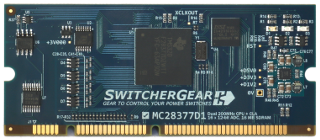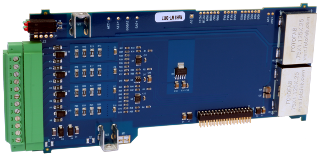SwitcherGear Overview
Why SwitcherGear?
In recent years, many products have become available to simplify the development of power converters. These include all-in-one solutions for the power stage (IGBT stacks and IPMs) and automated code generation.
Until now, developers have had to build their own custom controller …
What Is SwitcherGear?
SwitcherGear is a rapid-prototyping controller for power converters that:
- will save you time and keep your project costs down.
- can implement standard and novel converter types.
- is a comprehensive hardware solution, so you don't need to build custom interface circuitry.
Just add your preferred code development tools and a 24 VDC supply.
We help you to select a real-time microcontroller and interface modules that match your power converter application. Contact us with your application requirements.

Why Switch To SwitcherGear?
Speed-up development
Build your proof-of-concept converter using SwitcherGear and other proven, off-the-shelf parts before investing in a custom controller.
When your product development is stable, the SwitcherGear hardware is readily ported to a custom design that is firmware compatible.
Then, reuse SwitcherGear for your next great converter idea. Repeat.
Wide application
SwitcherGear has the resources and power to implement most power converter topologies …
- 3-phase motor drive and grid interface
- DC/DC - boost, interleaved, buck-boost
- Multi-level converters
- Novel and research topologies
- Novel control schemes
Comprehensive hardware solution
SwitcherGear offers everything you need to control a power converter …
- Auxiliary supplies for gate drivers, IPM, sensors, etc.
- Signal conditioning to match MCU
- Line drivers
- Galvanic isolation
- Protection
Real-Time Microcontroller
At the heart of the SwitcherGear controller is a high-performance, real-time microcontroller (MCU). Choose the MCU module that matches your application – from entry-level to high-performance MCUs.
Current MCU modules for SwitcherGear use Texas Instruments C2000 Piccolo™, Delfino™ and Concerto™. Minimum features for MCU modules include F28 CPU at 60+ MHz, 16-channel high-speed ADC, 12-channel PWM, SPI, etc.


Hardware Interface Modules
Hardware interface modules connect the SwitcherGear MCU to the physical world. You choose the type and number of modules to match the system under control.
The SwitcherGear ecosystem includes modules that are optimised for power converter systems – they offer direct connection to gate-drivers, IGBT stacks, current & voltage sensors and incremental encoders. Other modules interface to standard industrial analogue I/O, digital I/O and fieldbus.
Familiar Code Development Tools
Because SwitcherGear is based on standard MCUs, you develop your control and application code using widely available development tools. You may already have your own debug probe and software libraries that can be used directly with SwitcherGear. You can also take advantage of the large amount of freely available and third-party code for power conversion.
SwitcherWare Library
The optional SwitcherWare library provides classes that are wrappers for various hardware signal types, including digital I/O, analogue inputs and SPI. The classes take care of the initialisation of MCU registers and provide a convenient way to use the signals from your code.
A basic application framework is supplied with SwitcherGear as a starter for simple applications. Just add your control code at the commented locations in the source files.
Strict Real-Time Control
The SwitcherGear architecture preserves the real-time performance of your chosen MCU.
Gate driver PWM digital signals and phase current analogue signals are time-critical. Such time-critical signals are connected directly between the interface modules and MCU.
Non-critical I/O can be controlled using SPI bus.
Single Power Supply Operation
SwitcherGear is powered by a single 24 VDC supply input.
Hardware interface modules generate supply outputs at other voltages as required, e.g. ±12 V for hall-effect current sensors and +15 V for gate drivers.
Say goodbye to ugly stacks of laboratory power supplies.
Migration Path To Production
SwitcherGear is based on the same microcontrollers and interface hardware that are used in production controllers.
This makes it simple to port the hardware of your SwitcherGear controller to a custom PCB design. It also means that the code developed for SwitcherGear is ready to run on the custom production controller.